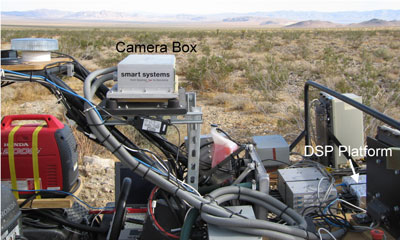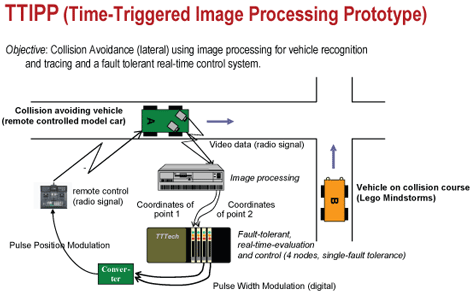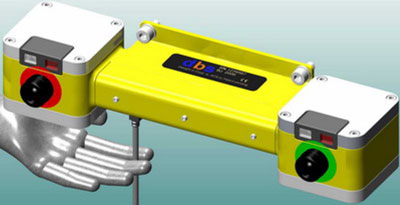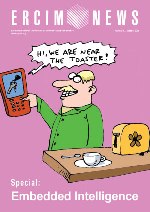by Erwin Schoitsch and Wilfried Kubinger
Embedded systems are everywhere today and will be even more prevalent in the future. Most of them perform simple control and support tasks on command in a pre-programmed manner, but that's not the end of the line. Increasingly, they are designed to carry out autonomous tasks including "intelligence" (smart systems). They are also designed to be able to decide, based on complex inputs and situation awareness, what to do under circumstances defined by an unreliable environment. Autonomous vehicles are the next step in this direction.
Basic characteristics of embedded systems are that distributed, networked electronic control units (ECUs) are integrated into their technical or natural environment, linked to sensors and actuators with properties like cognition and situation awareness and controlled by robust algorithms which implies some 'intelligence' (smart systems). Applications are to be found in many domains: safety-critical applications include aerospace, railways, automotive applications, machinery and medical systems, as well as entertainment. Challenges relate to the dependability (safety, reliability and security) of hardware, software and systems design, communication technologies, sensors, actors, materials etc. The Integrated Project DECOS is carrying out research into the design and development of holistic dependable systems, providing the fundamental architecture and services in a domain and platform independent manner.

The next step on from a collection of "intelligent embedded functions" is the development of autonomous systems. These are able to perform complex missions in an autonomous manner, coping with unexpected incidents and interactions from the environment. They need to meet two basic criteria in the range of their activity, especially in case of interaction with people:
-
a dependable, robust infrastructure as a basis of the system (as developed, for example, by DECOS)
-
robust and reliable algorithms, sensors and actuators, situation awareness and cognition.
The next step would be co-operative systems consisting of an ad hoc set of autonomous systems (eg autonomous platooning of cars on a highway, controlling the traffic-flow by car-to-car communication).
ARC Seibersdorf research is doing research in the area of autonomous systems, especially in the area of automotive and other mobile transportation systems, providing vision systems (optical and laser light systems), advanced driver assistance systems, recognition/identification of, for example, traffic signs, demonstrations of platooning systems (model cars) and with robots (partner in the recently accepted robots@home proposal, a STREP of FP6).
DARPA Grand Challenge, Automotive Applications
A significant milestone in the development of autonomous vehicles was the DARPA Grand Challenge (Defense Advanced Research Projects Agency, USA). The driverless vehicles had to complete a course over 132 miles (212 km), through desert land with off-road type terrain in the Mojave Desert, without any external support.
Figure 1 shows SciAutonics/Auburn Engineering's autonomous vehicle, RASCAL (Robust Autonomous Sensor Controlled All-Terrain Land Vehicle). They invited ARC Seibersdorf research's Smart-Systems team to provide their embedded stereo vision module SMART EYE SVS (including all the algorithms for detection and identification of obstacles, lanes, tracks, etc.). The vision system performed beyond expectations: RASCAL was one of the fastest vehicles in the qualification event, where only 23 out of 40 (of more than 160 that applied) qualified for the final race. RASCAL came 16th in the end, because of a failing communication hub.
The 2007 DARPA Grand Challenge will take place in an urban environment. This means that if the mission cannot be fulfilled because of a closed lane, the vehicle has to turn and autonomously decide which alternative route to take, obeying traffic rules.
The embedded stereo vision sensor will be tested in other environments too (a concept car for advanced driver assistance systems) and in a platooning experiment with model cars.
Figure 2 shows another demonstration of highly-dependable system technology - the TT Vision node application (Time-Triggered Vision node, applying TT technology to a demonstrator, avoiding a crash by either stopping or speeding up depending on the situation).

Autonomous vehicles are of primary importance in dangerous environments where human drivers would be at risk of their lives and will, in future, allow safer transport on roads.
Autonomous RobotsOther short-distance vision systems in industrial environments for autonomous robots have been tested with laser light systems. Figure 3 shows such a laser light stereo system.
The advantage of the laser light section system, which was implemented in a feasibility study for a mobile robot system in an industrial environment, is its simplicity and low price.
The smart systems team of ARC Seibersdorf research is a partner in the STREP initiative 'robots@home' of the last IST Call 'Advanced Robotics'. The goal is to develop an open mobile platform that is able to navigate in the different home environments encountered in European and international homes. The home environment poses another set of challenges yet to be resolved: changing environment, tables and chairs with thin feet, glass objects, humans crossing the way, different materials and objects difficult to identify, unreliable environment. The robot needs to be able to 'learn' a new environment in a natural manner by accompanying a person around a room, it needs to be able to classify objects and obstacles and react to different stimuli - and all without the owners doing some type of 'programming' or 'configuration'. This open platform is intended to be a building block for service and personal robots for many different home applications and ambient assisted living tasks.

The consortium is composed of teams from TU Vienna, ARC Seibersdorf research (Austria), ETH Zurich, BlueBotics, Securitas SA, Nestle Nespresso SA (Switzerland), Legrange SA (France), and Otto Bock HealthCare GmbH (Germany).
Links:
http://www.smart-systems.at
http://www.decos.at
Please contact:
Wilfried Kubinger, Erwin Schoitsch, ARC Seibersdorf research/AARIT, Austria
Tel: +43 50550 4200, 4117
E-mail: {wilfried.kubinger, Erwin.schoitsch}![]() arcs.ac.at
arcs.ac.at










